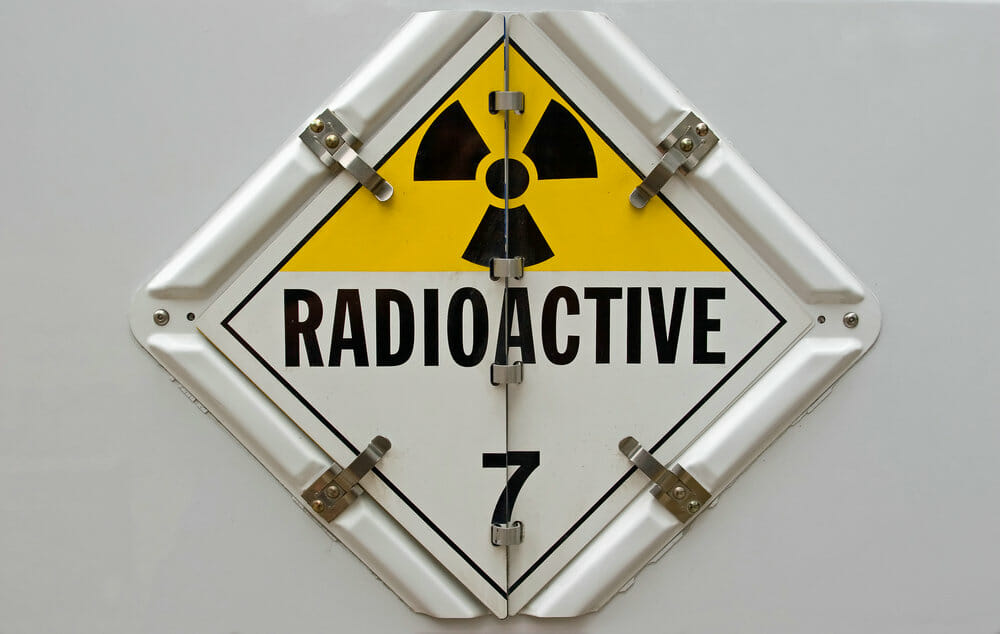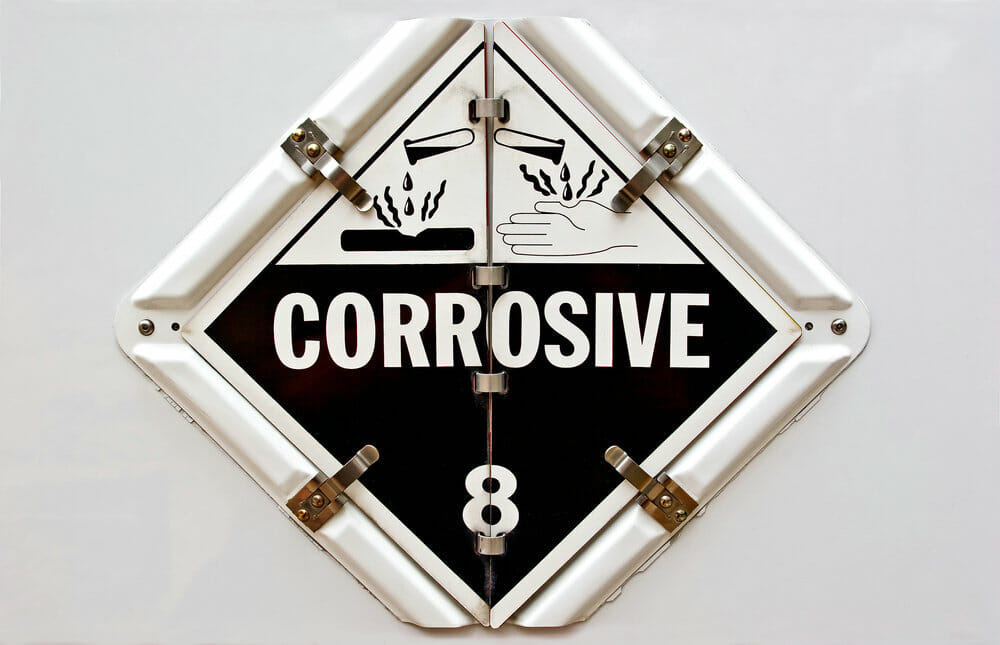Further, hazardous materials that could catch fire or explode under specific conditions, such as wetness and moisture, are dangerously reactive substances. They could exist as gases, liquids, or solids. Chlorine and hydrogen are two examples of typical dangerously reactive materials.
Class 5 Organic Peroxide And Oxidizing Agents
Ideally, the hazardous materials in this class are classified into two divisions. These are materials that produce oxygen when burning. The hazmat loads in this class can be placed within the following divisions:
- Oxidizers such as hydrogen peroxide
- Organic peroxides such as bleach
Oxidizing agents are dangerous substances that have the potential to ignite and burn other things. They could exist as gases, liquids, or solids. Common oxidizing agents include oxygen and nitric acid, for instance.
Hazardous compounds like organic peroxides have the potential to ignite or explode. They could exist as gases, liquids, or solids. Acetone peroxide and methyl ethyl ketone peroxide are two examples of typical organic peroxides.
Class 6 Toxic And Infectious Substances
The hazardous materials in this class are usually categorized into the following divisions:
- Poisonous materials such as pesticides.
- Etiologic (infectious) substances.
Hazardous materials, known as toxic chemicals, can be inhaled, swallowed, or absorbed via the skin, resulting in death or serious harm. They could exist as gases, liquids, or solids. Arsenic and cyanide are two instances of typical poisonous chemicals.
Hazardous compounds that can infect humans or animals are known as infectious substances. They could exist as gases, liquids, or solids. The most prevalent infectious agents include bacteria and viruses.
Class 7 Radioactive Material

The hazardous materials placed in this hazmat class are those that contain radioactive compounds. This means that they emit radiation which is a dangerous substance. They could exist as gases, liquids, or solids. The radioactive elements uranium and plutonium are two examples.
Additionally, anything that produces more radioactive activity per gram than.002 microcuries are considered radioactive substances. This classification includes items that include uranium and radium but does not break them down into subclasses.
Class 8 Corrosive Materials

These are substances that are intended to corrode in any form. Some of the hazmat goods that can be placed in this category include lithium-ion batteries and home cleansers. They could exist as gases, liquids, or solids.
Class 9 Miscellaneous Hazardous Goods
This class is for items that could be hazardous but don’t fit into any of the other eight categories. Dry ice, automotive components (such as airbags), and lithium-ion batteries are a few examples of items within class nine. They come in solid, liquid, or gaseous forms.
Regulations Of Hazmat Shipping
A shipping paper prepared in compliance with the HMR must accompany any hazardous substance that a carrier transports during a hazmat freight. Hazardous material shipping is subject to DOT regulations in the United States.
To ensure the safe transportation of hazardous goods, the Department of Transportation (DOT) has tight guidelines, the Hazardous Materials Transportation Act, and hazardous materials regulations that must be adhered to.
These guidelines and laws on hazardous materials are intended to safeguard the general people and the environment from any potential negative impacts of hazmat items.
As a shipper, it’s crucial that you familiarize yourself with all the applicable laws on hazmat freight. This will help you have an easy time transporting hazardous materials.
Important Factors During A Hazmat Freight
There are several crucial factors that you must consider if you want to ship hazardous materials. These factors include the following:
Labeling
As a shipper, you are responsible for correctly labeling hazmat packaging. For each of the many classifications, the DOT has developed labels. They must be printed by the shipper and cannot be made by hand without incurring penalties. The DOT distinguishes these labels according to their size, shape, and color.
Packaging
Another important aspect during hazmat freight is the packaging of hazardous materials. Different classifications apply when you ship hazardous items. You must ensure that all the hazardous materials are in the correct “packing group.”
This rating is meant to assist carriers in determining the package’s potential danger and, consequently, the appropriate handling strategy. The DOT divides these organizations into three categories:
Package Group I: Hazardous materials within the category present the greatest risk. This indicates that the components in the package have the potential to harm the environment the most if handled improperly.
Package Group II: Hazardous materials that fall under this division are considered to be of a moderately harmful nature. They aren’t benign, but they will only do a little damage if a carrier mishandles them.
Package Group III: The third package group includes products with the lowest environmental risk. They still offer a risk and need to be handled carefully, but given the material’s intrinsic danger, they do so with the least risk.
Proper Documentation
A Shipper’s Declaration for Dangerous Goods is required if you want to ship hazardous materials. Ensure that all the information regarding the hazardous goods being sent and the good practices for handling and transporting the materials are included in this document.
According to federal law, 49 CFR Part 172 Subpart C outlines the regulations for shipping paper. A shipping paper is any shipping document that complies with this Subpart’s standards and communicates a hazard for the purposes of the hazardous materials regulations.
Each person who offers to carry hazardous items must list the materials on a shipping document that complies with the HMR’s specifications. A shipping paper prepared in compliance with the HMR must accompany any hazardous substance that a carrier transports.
Further, it’s crucial to keep in mind that a material that is not a hazardous material in accordance with this subchapter may not be offered for transportation or transported if its description on a shipping paper includes a hazard class or an identification number specified in 49 CFR 172.101, with the exception of materials in the U. N. Recommendations, the ICAO Technical Instructions, or the IMDG Code.
Moreover, according to hazmat shipping regulations, the shipping paper must provide a phone number for emergency assistance. The phone number provided is often under surveillance during the transportation of hazardous materials and storage.
The contact information must be that of a person who is familiar with the hazardous products being sent and the proper emergency response protocols or who has rapid access to someone who does.
You must have an active contract with the service provider if you use the number for one, such as CHEMTREC. The mailing paper must prominently include this phone number.
Marking
Similar to labeling, 49 CFR, Subpart D, Part 172 outlines the standards for package marking. A package must be marked with the proper shipping name and identification number for any hazardous materials it contains. The markings must be legible, in English, and not covered by other labels or markings.
There may be additional marking requirements depending on the material. If 172.203 mandates it, technical names for non-bulk packaging must be marked in parenthesis with the correct shipping name (k). ORM-D and restricted quantities don’t require identification numbers.
Hazmat Transportation Process
The process of transportation of hazardous materials is similar to other goods. The significant difference is in the care and safety measures that must be adhered to during a hazmat freight.
The first step if you want to transport hazardous materials is to find the right shipping container. This can be challenging because some regulations and standards provide which containers should be used for specific hazmat loads.
For instance, if you’re shipping hazmat loads that contain paint, chemicals, flammable liquids, and radioactive materials.
In addition, you should ensure that your employees or freight forwarders are properly trained. Adequate training can help ascertain that your workers understand the crucial factors to consider when choosing a container for your hazmat shipments.
Once you have the container, the next step is to ensure it’s properly labeled. This entails printing the label’s proper cautions, directions, and shipping name. Serious penalties could be imposed if you don’t.
Ensure that you also include any special instructions on the label of the hazmat shipment. Further, the label should be placed in a visible location for convenience throughout the freight.
The final step is to ensure that the hazardous materials are properly packed. At this stage, ensure that they are in the correct packing group and packed according to the regulations of the specific hazmat class.
In addition, properly packing hazmat loads would ascertain that they’re safe for shipping. When shipping hazardous materials, it would be detrimental to have leaks or spills while in transit.
A Shipper’s Role In Shipping Hazardous Materials
The shipper carrying the hazardous freight is responsible for disclosing the precise requirements. If you don’t have the necessary information and knowledge on moving hazardous materials as a shipper, it’d be best to hire a freight forwarding company.
In addition, to reduce confusion, it is crucial to express the details of these products in clear terms before giving a supplier the freight. If the supplier has details on the hazmat materials they’re transporting; it’d be easy to ascertain safety.
Shippers transporting hazardous materials must provide all necessary information utilizing a well-maintained material safety data sheet (SDS) to assist them in doing this. You can also use a hazardous materials table to properly classify and provide details on the hazmat materials being transported.
A Broker’s Role In Hazmat Shipping
Brokers for hazmat shipments must be certified to transport hazardous items. A freight brokerage needs a hazardous certification before they can plan any form of hazmat freights.
Unlike the hazmat certifications of shippers and consignees, this certification is not concerned with the safe handling and storage of hazardous materials. Instead, a brokerage’s accreditation focuses on adhering to the Federal Hazardous Materials Regulations of the Department of Transportation (HMR).
Brokers must uphold specific levels of professionalism in hazardous transportation because they act as the shipper’s representative. Brokers who want to keep their license, which expires after three years, must be well-versed in all hazmat shipping-related issues.
The broker should also be well-versed in the following areas:
- Hazmat classes
- Hazmat packaging and placarding rules
- Shipping documentations
Furthermore, ensure that you ask your freight brokerage how they go about keeping their hazmat certification since maintaining it may be such a complicated procedure.
Relationship Between Safety And Hazmat Freight
The most important consideration when transporting hazmat loads is safety. When the proper packaging and equipment are utilized, the correct product information is declared, and all the requirements governing the transportation of hazmat goods are followed, it is possible to transport hazardous chemicals without any problems (federal hazardous materials regulations).
As mentioned before, all documents submitted by shippers must include a reliable emergency number the carrier can call in case something happens and the required information concerning UN numbers.
The safety of people and the environment is the most crucial concern for us as a freight company. The class of hazardous substances present within our shipping containers must typically be declared on placards attached to the outside of the freight.
Additionally, the shipping captains and truck drivers must be Hazmat Certified, and their commercial driver’s license should display the Hazmat Endorsement (CDL). Hazardous materials shipping can be done securely and without adding extra time to your shipment if all necessary safety precautions are taken, and everyone in the supply chain is appropriately trained and certified.
The Best Hazmat Freight Company
If you’re considering moving hazardous materials anywhere in the world, you’ll need a reliable and certified hazmat freight company. Luckystar Logistic offers the best hazmat freight services in the industry.
Our company has invested in ensuring that we have a team of experienced and trained professionals handling any hazardous material. The team guarantees to handle your hazardous material with utmost care and attention to detail.
We also offer a variety of shipping options for hazardous materials. Your choice of shipping method can be determined by your needs and the type of hazmat cargo being shipped. The shipping methods available include the following:
- Air freight
- Sea Freight
- Land trucking transportation
You can consult with us on the best shipping method for you.
Additionally, we’ve ensured that all our employees are trained and certified as per hazmat shipping regulations and protocols. This is to ascertain that your dangerous goods are shipped easily and without delays.
As a company committed to safety and compliance when shipping hazmat cargo, we’re the best in transporting hazardous material. You can contact us to learn more about how we can help with your shipping needs.
Conclusion
Hazmat transportation is a sensitive issue that should be handled with utmost care and attention. It’d help if you hired a freight company such as Luckystar Logistic to handle your hazmat transportation needs.
Further, several factors must be considered when handling hazmat material, such as classification, labeling, and legal regulations. Ensure that you enroll in the services of a freight company to help with shipping hazmat cargo.
